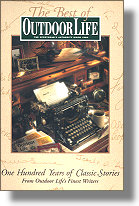Heaven Is A Steelhead, Concluded
By Joe Brooks
Moses raised another point that day.
"I've always thought that the longer the leader the better your chances
for fish," he said, "But we're using short leaders."
"When you use a sinking line," I said, "the leader should be no longer
than six feet. A ten or twelve-foot leader such as we use in most trout
fishing would only defeat the purpose of the sinking line. The heavy line
would go down, all right, but the current would force the long, light
leader - and the fly - up toward the surface and out of bounds for deep-lying
fish. The short leader keeps the fly down where you want it, only inches from
the bottom."
(In any big steelhead river, long casts are usually needed. For that reason, as
well as for ease in handling the sinking lines, I advise steelheaders to use a 9 or
91/2-foot fly rod. With such a stick you can throw either the WF-9-F/S or
the sllightly heavier WF-10-F/S line. The number in each line designation
classifies the weight of the first 30 feet of the line. The designation WF-9-F/S
means that the line is a weight-forward floater-sinker in which the first 30 feet
weigh 250 grains, thus making the line a No. 9 according to standards set by
the American Fishing Tackle Manufacturers Association. The WF-10-F/S
is the same type of line but has a 30-foot weight of 300 grains. I like the
lighter of those two lines for fairly shallow water and the heavier one for
deeper water. The No. 10 line sinks faster and makes long throws a little
easier.)
On my first trip to the Babine, Bill McGuire had handed me a shooting basket
and insisted that I use it. As I said earlier, most steelhead rivers demand
extra-long casts - throwing 80 to 100 feet. To handle that much line while
wading, it is almost essential to use a shooting basket.
If you don't, you must loop the shooting line in the fingers of your free hand,
and the long coils often drape in the water, twist in the wind, or become entangled
and bunch up against the rod's first guide, spoiling what could have been a fine
throw.
With the shooting basket strapped around your waist just above your belt,
you can strip in line so that it lies in neat coils in the basket. When you
make the next cast, the line slips out freely and easily.
"When you're ready to retrieve," Bill had told me, "tuck your rod under your
arm and use both hands to strip the line into the basket in front of you. You can
use a lot more line this way than if you tried to hold it in your hand."
I did as he said, and it was a pleasure on the next throw to see the line's
heavy head go out and then to look down into the basket and see coil after
coil disappear.
Best fly patterns for steelheads vary according to the river being fished,
and they are used both weighted and unweighted. In general, the best
patterns, especially for winter steelheads and during last runs in big rivers
such as the Babine, show some pink, red, or orange, along with some white.
These flies are tied to imitate salmon eggs, on which steelheads feed
heavily.
On the Babine we used all the color combinations just mentioned. We started
with No. 4 and No. 6 hooks but eventually went to 1/0 because we found that
these bigger hooks bit better into the mouths of big steelheads.

Our favorite pattern was the Babine Special, first tied by Bill McGuire. It
has an orange body with a pinched-in center, a white hackle, and no tail. Its
design is very simple, but that was the fly we all came of depend on.
Rex Palmer of Seattle tied another good one. It has an orange body, white
hackle and a green tag. He calls it the Palmer Special.
As far as I have been able to discover, no one has ever taken a steelhead
from the Babine on a dry fly. Next time I'm there, I intend to put in some
time trying to do just that. ~ Joe Brooks
*Publisher's Note: The above story is by the late Joe Brooks,
written for OutdoorLife magazine in 1968. This excerpt is from
a wonderful book, The Best of OutdoorLife, One Hundred Years
of Classic Stories. We thank Cowles Creative Publishing, Inc. for use
permission. ~ dlb
If you missed the other installments of Heaven is a Steelhead, here they are:
Heaven is a Steelhead - Part 1
Heaven is a Steelhead - Part 2
Heaven is a Steelhead - Part 3
Heaven is a Steelhead - Part 4
|


